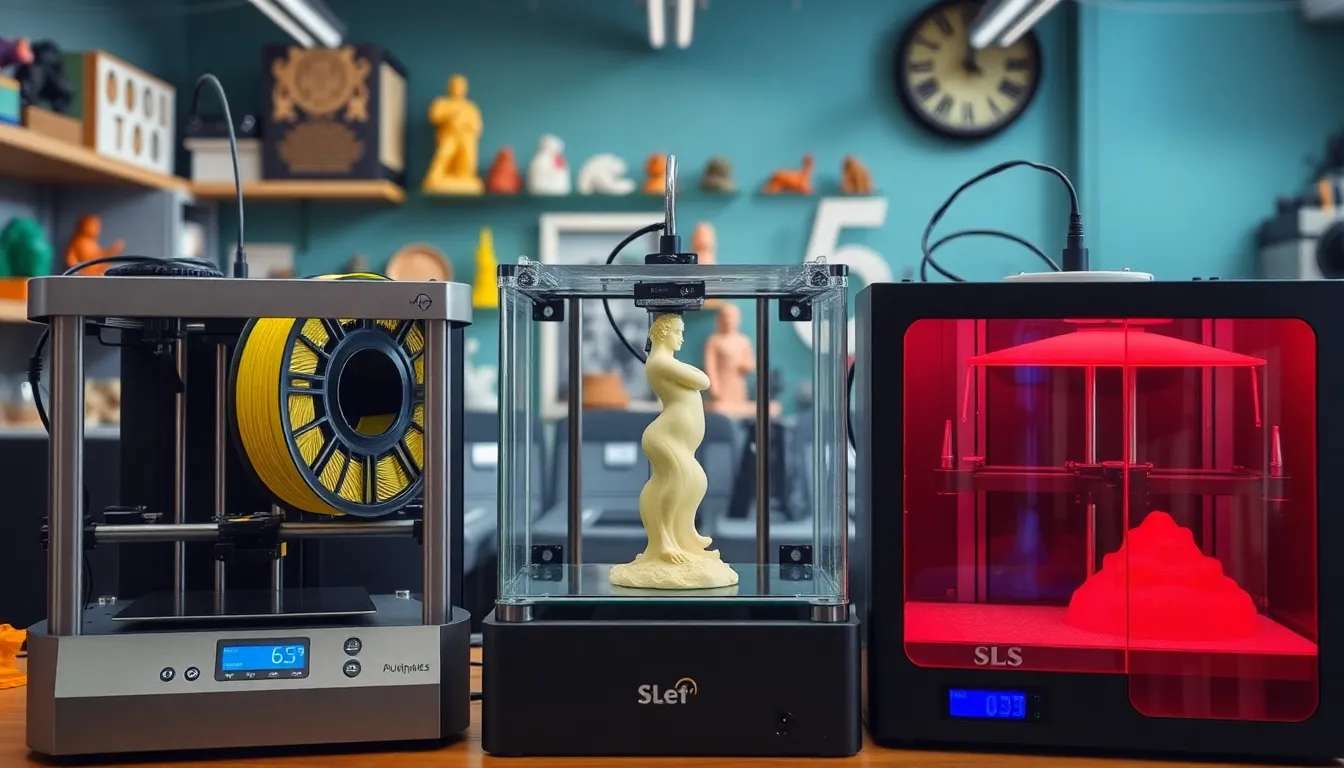Imagine a world where your wildest ideas spring to life with just a click. Enter the realm of 3D printers, the magical machines turning dreams into tangible creations faster than you can say “abracadabra.” Whether it’s a quirky coffee mug or a prototype for the next big invention, these printers are revolutionizing how we create and innovate.
Table of Contents
ToggleOverview of 3D Printers
3D printers utilize an additive manufacturing process to create objects layer by layer from digital designs. Common materials include plastics like PLA and ABS, metals, and even bio-materials. Numerous technologies exist within the realm of 3D printing, such as Fused Deposition Modeling (FDM), Stereolithography (SLA), and Selective Laser Sintering (SLS). Each technology offers distinct advantages suited for various applications.
FDM, the most popular method, works by extruding melted filament through a nozzle, forming shapes that cool and solidify quickly. This technique is especially favored for prototyping and creating custom parts. In contrast, SLA employs a light-sensitive resin that solidifies when exposed to UV light, achieving higher detail and smoother finishes. Popular among designers and engineers, this method excels at producing intricate designs.
SLS uses a laser to fuse powder particles together, generating complex geometries without the need for support structures. This technique is commonly utilized in aerospace and automotive industries, enabling the production of lightweight yet strong components. Customization remains a key element, allowing users to adjust designs according to specific needs.
Applications of 3D printers vary widely, ranging from medical devices to consumer products. Industries increasingly rely on 3D printing for rapid prototyping and low-volume production. It’s estimated that the global 3D printing market will reach $34.8 billion by 2024, reflecting the growing adoption of these technologies. As 3D printing continues to evolve, it transforms traditional manufacturing methods and paves the way for innovative solutions.
Types of 3D Printers

3D printers come in various types, each tailored to specific applications and materials. Understanding these types helps users select the most suitable printer for their projects.
FDM Printers
Fused Deposition Modeling (FDM) printers represent the most commonly used type of 3D printer. These machines operate by extruding thermoplastic filament through a heated nozzle, layer by layer. Users favor FDM printers for their cost-effectiveness and ease of use. Makers often utilize them for prototyping and producing functional parts due to their versatility. Materials like PLA and ABS are popular choices, offering an array of colors and properties. The simplicity of FDM printers encourages widespread adoption among hobbyists and professionals alike.
SLA Printers
Stereolithography (SLA) printers excel in producing highly detailed and smooth-finished objects. This technology employs a UV laser to cure liquid resin, which solidifies layer by layer. Many artists and designers prefer SLA for its ability to create intricate designs with fine features. Resin materials provide superior surface quality and precision, making them ideal for detailed models and dental applications. Users often appreciate the faster print times compared to other types of printers. SLA’s capability to produce complex geometries further enhances its appeal in various industries.
SLS Printers
Selective Laser Sintering (SLS) printers harness the power of a laser to fuse powdered materials, creating robust parts. This technology supports numerous materials, including nylon and metal, which allows for a wide range of applications. Users benefit from SLS’s ability to produce complex geometries without the need for support structures. Consequently, this feature enhances design freedom significantly. Industries such as aerospace and automotive leverage SLS for producing lightweight components. The durability of SLS-printed parts meets the demands of functional testing and end-use applications.
Applications of 3D Printing
3D printing finds applications across numerous industries, revolutionizing traditional practices and enabling innovation.
Industrial Uses
Manufacturers utilize 3D printing for rapid prototyping, streamlining product development. It allows for the creation of complex parts that would be difficult or impossible to produce with conventional methods. Industries such as aerospace and automotive benefit significantly from this technology, producing lightweight components that enhance performance. Companies frequently reduce material waste by using additive manufacturing techniques, aligning with sustainability goals. Custom tooling and fixtures represent another industrial application, allowing manufacturers to optimize their production processes efficiently.
Medical Applications
In the medical field, 3D printing plays a pivotal role in personalized healthcare solutions. Surgeons often use patient-specific models for pre-surgical planning, enhancing precision during operations. Additionally, bioprinting technology advances tissue engineering by creating intricate structures that mimic human tissues. Prosthetics benefit from customization, offering improved comfort and functionality to users. Dental practices leverage 3D printing to produce crowns and aligners quickly and affordably, significantly increasing efficiency in patient care.
Consumer Products
Consumers experience the impact of 3D printing through bespoke products tailored to individual preferences. Personalized phone cases and jewelry represent a tiny fraction of what’s possible, showcasing the capability of on-demand production. Companies increasingly leverage 3D-printed items to enhance customer engagement by involving them in the design process. Home decor items also emerge as popular choices, allowing for unique designs that reflect personal style. As technology improves, the variety of consumer products produced by 3D printers continues to expand, making it easier to access personalized solutions.
Advantages of 3D Printing
3D printing offers numerous advantages that enhance creativity, efficiency, and personalization in various industries.
Customization
Customization stands as a significant advantage of 3D printing technology. Users can design unique products tailored to their specific needs, allowing for a broad range of personal preferences in everything from jewelry to medical implants. Companies can easily create prototypes that reflect their brand’s vision, resulting in innovative designs that capture consumer interest. The ability to modify digital files means rapid iterations are possible, leading to refined products that resonate with target audiences. Individuals benefit from bespoke solutions, making 3D printing a valuable tool for both consumers and businesses alike.
Cost-Effectiveness
Cost-effectiveness drives many companies to adopt 3D printing technologies. Traditional manufacturing often incurs heavy expenses related to materials, labor, and equipment maintenance. In contrast, 3D printing minimizes waste by using only the required amount of materials for each project, reducing overall costs. Rapid prototyping enables businesses to test multiple designs without large investments, ensuring that only successful products reach the market. Short production runs become feasible, allowing small businesses to maintain profitability while offering customized products. An efficient approach to manufacturing emerges, making 3D printing an economical choice for many.
Speed of Production
Speed of production presents another key advantage of 3D printing. Compared to traditional methods, 3D printing accelerates the manufacturing process significantly. Items can be produced in a matter of hours rather than days or weeks, particularly for complex designs that would require extensive assembly. This rapid turnaround allows companies to respond quickly to market demands, fostering a competitive edge. Furthermore, prototyping becomes faster, enabling designers to iterate and refine their ideas almost instantly. In industries such as aerospace and automotive, this agility translates to reduced lead times and enhanced innovation, driving progress within those fields.
Challenges in 3D Printing
3D printing presents several challenges that impact its effectiveness and adoption. Addressing these challenges is essential for maximizing benefits and enhancing the technology’s potential.
Material Limitations
Material options for 3D printing remain constrained, limiting feasible applications. Most commonly used materials include plastics and metals, yet each type has specific properties and limitations. While FDM printers utilize thermoplastics, SLA printers rely on photopolymers that can be expensive. SLS offers enhanced flexibility with powdered materials, yet the compatibility with various materials isn’t universal. Significant challenges arise in achieving strength, durability, and precision across diverse projects. Innovations in material science could help unlock new possibilities, but current choices hinder broader implementation.
Technical Complexity
Technical complexity stands as a barrier to entry for many users. Mastering 3D printing technology requires understanding intricate software and hardware components. Users often confront challenges related to printer calibration, slicing software, and design intricacies. Additionally, the learning curve can discourage beginners and slow down production timelines. Operations can become even more complex when scaling up for larger projects or integrating with existing manufacturing processes. Simplifying these processes through user-friendly tools and comprehensive support will enhance accessibility and efficiency in 3D printing applications.
3D printing stands at the forefront of innovation and creativity. Its ability to transform digital designs into tangible objects opens up endless possibilities across various industries. As technology evolves the applications of 3D printing continue to expand, making it an indispensable tool for both professionals and hobbyists.
While challenges like material limitations and technical complexity exist, ongoing advancements promise to address these issues. The future looks bright for 3D printing as it reshapes manufacturing processes and enhances personalization. Embracing this technology not only fosters creativity but also drives efficiency and cost savings, solidifying its place in the modern landscape of production and design.



